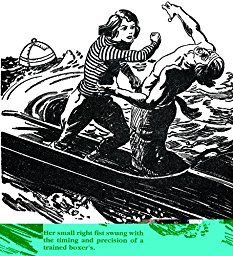Pulp Dames v Playboy Bunnies
I have been posting some images from my collection of pulp covers of late, in honor of the ongoing renaissance of pulp.
The pulp renaissance is part of a long overdue rediscovery in the related genres of space opera, boy’s SF, superversive SF, Sad Puppy SF, and all the genres rebelling against the gooey gray postrational postliterate politically correct orthodoxy drenching and smothering the field currently.
The rebels have the spirit of pioneers eager to discover for their generation the principles of sound story telling. Odd as it sounds to call an archaeologist a trailblazer, the term in this case is apt: the things brought to light are new to this generation. Their like has not been seen before, not by their eyes.
We often hear complaints by the uninformed that women in the pulp days were portrayed of women as trophies, damsels in distress, or eye candy in the pulps, and nothing but.
Whether the idea is valid or not that seeing a shapely astronaut menaced by moon-men or shapely reporter girl abducted by the Wax Museum Murder Ape diminishes the esteem in which gentlemen regard ladies (or, for that matter, spunky gun molls), the idea that pulps portrayed this “and nothing but” is not valid.
I have not sat down and counted the number of fainting Nell Fenwick or Princess Daphne girls versus the number of Warrior Queens of Mars, Annie Oakley gunslingers, or Patricia Savage adventure girls shown belting or blasting mooks with their smoke-wagons (or space pistols, space whips, space swords, or lightning bolts, etc.), but if there is a disparity in the number, it is not blatant.

By way of example, above is an interior illustration from”Brand of the Werewolf”, the Doc Savage adventure in which his fiery cousin, Patricia Savage, first makes her appearance. She appears in 37 Doc Savage stories. That is nearly one fifth of all the adventures of the Man of Bronze. She also fences, shoots, and knows ju jitsu, speaks a dozen languages including Mayan, she can read lips and pick pockets and can fly a plane. The publication date is January 1934.
For those of you who cannot make out the text, it reads: HER SMALL RIGHT FIST SWUNG WITH THE TIMING AND PRECISION OF A TRAINED BOXER’S.
Nor is Pat Savage some unique one-off adventure girl. Look up Nita Van Sloan from THE SPIDER, or Margot Lane from THE SHADOW, or any number of cavegirls, cowgirls, or sword-wielding amazons from the action yarns of the day.
Indeed, looking at my own bookshelf, I notice a drop in the number of action girls as we move past the war years. The portrayals of women as little more than Playboy bunnies does not come from reprints from the pre-war years, nor even from the Campbell science fiction yarns of the Golden Age of Hard SF, but from the Playboy bunny years, under the pen of authors like Bob Heinlein and Keith Laumer.
You may not be old enough to recall, but in the 196o’s and 1970’s feminism made a common cause with pornographers like Hugh Hefner, and in general sided with the Sexual Liberation movement.
Modesty and delicacy in women was regarded as a sign of oppression. The idea was that by ridding the distaff sex of all signs of civility, dignity, purity, virtue, and breeding, the honor due women would increase. Somehow.
In other words, by jettisoning everything that engenders respect in men, the idea was that more respect would be engendered (rather than less).
But the reaction was not against the way women were portrayed traditionally. It was one group of deviants, the Sexual Liberation types who favored breaking the old standards of modesty and chastity, fighting another group of deviants, the Sexual Liberation types who wanted women to be sexless while being just like men while being better than men. The modern Affirmative Action Heroine overthrows the stereotype of the Playboy Bunny by making her an unfeminine or foul-mouthed version of the adventure girls from the pulp days. But the claim is that the stereotypes of the pulp days are what need to be trampled to liberate women.
Bosh. The trope of a martial maiden, a woman who fights as well as a man, is common enough in the West. Pat Savage has a long line of military mothers. Look at Camilla in Virgil, Ariosto’s Bradamante and Marfisa, Tasso’s Clorinda, and Spenser’s Britomart and Radigund. This is without mentioning the Amazons of Greek mythology.
Anyone seriously wanting to increase the honor and respect due to women in the world, would take a hard look at what one single force in history ended polygamy, ended concubinage, ended non-consensual marriage, and what ideas governed peoples who granted women the legal right to own property, vote, and serve in the professions or public offices. Since she is a force, or, rather, institution, routinely blamed for the very problems she alone alleviates, I decline to utter the name. Look into the matter yourself, come to your own conclusions.
But I am confident you will find that the whole Sexual Liberation movement is a falsehood from start to finish.
It is unfortunate that part of that falsehood includes a need to revile and demean the perfectly hale and commonplace entertainments of yesteryear.
